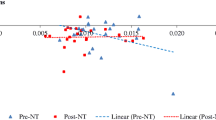Abstract
Market trends have been one of the highly debated phenomena in the financial industries and academia. Prior works show the profitability in exploiting transactions via market trend quantification; on the other hand, traders’ behaviors and effects on the market trends can be better understood by market trend studies. In general, the trading strategies on the market trend include trend following strategies and contrarian strategies. Following the trend, trading strategies exploit the momentum effects. The momentum strategies profit in a long position with the rising market prices, as well as in a short position with the decreasing market prices. On the contrary, the view of contrarian trading strategy is based on the mean-reversion property, i.e., a long position is taken when the price moves down and a short position is taken when the price moves up. In this paper, we apply the stop-loss and stop-profit mechanisms to verify the market trends based on two new simple strategies, i.e., the BuyOp. strategy and the BuyHi.SellLo. strategy. We back-test these two strategies on the Taiwan Stock Exchange Capitalization Weighted Stock Index Futures (TAIEX Futures) during the period from May 25, 2010 to August 19, 2015. We compare the numerical results of its profits and losses through various stop-loss thresholds and stop-profit thresholds, and verify the existence of the momentum effect via applying these two new trading strategies. Besides, we analyze the market trends through the repeated simulations of random trades with the stop-loss and stop-profit mechanisms. Our numerical results reveal that there exist momentum effects in TAIEX Futures, which verifies the market inefficiency and the market profitability in exploiting the market inefficiency. In addition, the techniques of random trades are also applied to the other commodities, such as AAPL in NASDAQ, IBM, GOOG in NYSE, and, TSMC in TPE, and so on. Surprisingly, not all the stocks have the momentum effects. Our experimental results show that some stocks or markets are more suitable for the mean-reverse strategy. Finally, we propose a technique to quantify the momentum effect of a financial market by using Jensen–Shannon divergence.


















Similar content being viewed by others
References
Ansari VA, Khan S (2012) Momentum anomaly: evidence from India. Manag Financ 38(2):206–223
Basu S (1977) Investment performance of common stocks in relation to their priceearnings ratios: a test of the efficient market hypothesis. J Financ 32(3):663–682
Borda M, Nistor I, Gherman M (2011) Opening range trading strategies applied on daily and intraday data: the case of BET index. Rev Econ Stud Res Virgil Madgearu 2:79–96
Brown BM (1971) Martingale central limit theorems. Ann Math Stat 42(1):157–170
Bollinger J (2001) Bollinger on bollinger bands. McGraw Hill, New York, NY, USA. ISBN 0-07-137368-3
Cekirdekci ME (2010) Trading system development: trading the opening range breakouts. Ph.D. Dissertation, Worcester Polytechnic Institute, Worcester
de Prado ML, Vince R, Zhu QJ (2013) Optimal risk budgeting under a finite investment horizon. SSRN Electron. J. Available at SSRN. http://ssrn.com/abstract=2364092 or doi:10.2139/ssrn.2364092
Fama EF (1970) Efficient capital markets: a review of theory and empirical work. J Financ 25(2):383–417
Holmberg U, Lönnbark C, Lundström C (2012) Assessing the profitability of intraday opening range breakout strategies. Financ Res Lett 10(1):27–33
Hung TW, Wu ME, Wang CJ, Hsu WWY, Ho JM (2014) On the design of trading schemes of equity funds based on random traders. In: Proc. of 2014 IEEE int. conf. granluar comput. (GrC’14), Noboribetsu
Jegadeesh N, Titman S (1993) Returns to buying winners and selling losers: implications for stock market efficiency. J Financ 48(1):65–91
MacLean LC, Ziemba WT (2006) The Kelly criterion: theory and practice. In: Handbook of asset and liability management volume a: theory and methodology. North Holland, Amsterdam
Park CH, Irwin SH (2007) What do we know about the profitability of technical analysis? J Econ Surv 21(4):786–826
Schulmeister S (2009) Profitability of technical stock trading: has it moved from daily to intraday data? Rev Financ Econ 18(4):190–201
Tharp VK (2008) Van Tharp’s definite guide to position sizing SM: how to evaluate your system and use position sizing. International Institute of Trading Mastery Inc., Cary
Tsai YC, Wu ME, Lei CL, Wu CS, Ho JM (2014) Comparing profitability of day trading using ORB strategies on index futures markets in Taiwan, Hong-Kong and USA. In: 10th annual conference of the Asia-Pacific association of derivatives, 21–22 August 2014, Busan, Korea
Vince R (2012) Risk-opportunity analysis. Create space independent publishing platform. ISBN 9781466344402
Vince R, Zhu QJ (2013a) Inflection point significance for the investment size. SSRN Electron J. doi:10.2139/ssrn.2230874
Vince R, Zhu QJ (2013b) Optimal betting sizes for the game of blackjack. SSRN Electron J. doi:10.2139/ssrn.2324852
Wikipedia, Jensen–Shannoon divergence. https://en.wikipedia.org/wiki/Jensen-Shannon_divergence. Accessed 16 Feb 2016
Wikipedia, Kullback–Leibler divergence. https://en.wikipedia.org/wiki/Jensen-Shannon_divergence. Accessed 18 Feb 2016
Zhu QJ (2007) Mathematical analysis of investment systems. J Math Anal Appl 326(1):708–720
Zhu QJ, Vince R, Malinsky S (2012) A dynamic implementations of the leverage space portfolio. SSRN Electron J. doi:10.2139/ssrn.2230866
Acknowledgments
The work of Mu-En Wu was funded by the Ministry of Science and Technology, Taiwan (MOST-104-2221-E-031 -004). The work of Wei-Ho Chung was funded by the Ministry of Science and Technology, Taiwan (MOST-104-2221-E-001-008-MY3).
Author information
Authors and Affiliations
Corresponding author
Ethics declarations
Conflict of interest
Mu-En Wu declares that he has no conflict of interest. Chia-Hung Wang declares that he has no conflict of interest. Wei-Ho Chung declares that he has no conflict of interest.
Ethical approval
This article does not contain any studies with human participants or animals performed by any of the authors.
Additional information
Communicated by C.-H. Chen.
Rights and permissions
About this article
Cite this article
Wu, ME., Wang, CH. & Chung, WH. Using trading mechanisms to investigate large futures data and their implications to market trends. Soft Comput 21, 2821–2834 (2017). https://doi.org/10.1007/s00500-016-2162-6
Published:
Issue Date:
DOI: https://doi.org/10.1007/s00500-016-2162-6




